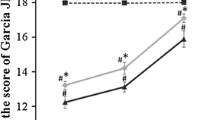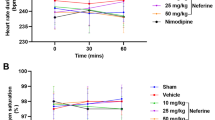Abstract
Ischemic stroke is the primary cause of disability and mortality worldwide. Ischemia/reperfusion (I/R)-induced microcirculatory dysfunction and organ injury generally occur after ischemic stroke. Several studies have shown that intermedin (IMD) has a regulating function on cerebral microcirculation and blood-brain barrier via relaxing cerebral vessels and improving the local blood supply after cerebral ischemia. However, a unified conclusion has not been reached, and the underlying mechanism remains unclear. To observe and analyze the changes of cerebral microcirculation perfusion of cerebral IRI by IMD post-treatment in the rats and further explore the mechanism underlying the beneficial effect of IMD on cerebral IRI. Thirty-nine rats were divided into three groups: sham, I/R, and I/R + IMD groups. After IMD ischemia post-treatment, the rat cerebral infarction rate and the degree of neurological deficit were evaluated by TTC staining and neurological function score; the changes in the amount of cerebral microcirculation implantation on the injured side of the rats were observed by laser Doppler; the pathological changes and cell ultrastructure of rat cortex and hippocampus were observed by HE staining and transmission electron microscopy; the neuron apoptosis in the rat cortex and hippocampus was detected by TUNEL staining and immunohistochemical staining. Impaired neurological function, abnormal cortical/hippocampal neuron morphology, and the proportion of cerebral infarction were significantly improved in the IMD group compared with the I/R group, which suggested a possible neuroprotective role of IMD. IMD treatment also increased the average perfusion of cerebral surface microcirculation in rats by astonished 42.7 times. Finally, IMD administration decreased the caspase-3- and Bax-positive cell numbers and apoptotic cell ratio. IMD has a significant protective effect on neuronal damage caused by cerebral I/R in rats by improving cerebral microcirculation and inhibiting apoptosis.





Similar content being viewed by others
References
Bell D, McDermott BJ (2008) Intermedin (adrenomedullin-2): a novel counter-regulatory peptide in the cardiovascular and renal systems. Br J Pharmacol 153(Suppl 1):S247–S262. https://doi.org/10.1038/sj.bjp.0707494
Bell D, Gordon BJ, Lavery A, Megaw K, Kinney MO, Harbinson MT (2016) Plasma levels of intermedin (adrenomedullin-2) in healthy human volunteers and patients with heart failure. Peptides. 76:19–29. https://doi.org/10.1016/j.peptides.2015.12.003
Benjamin EJ, Virani SS, Callaway CW, Chamberlain AM, Chang AR, Cheng S, Chiuve SE, Cushman M, Delling FN, Deo R, de Ferranti SD, Ferguson JF, Fornage M, Gillespie C, Isasi CR, Jiménez MC, Jordan LC, Judd SE, Lackland D, Lichtman JH, Lisabeth L, Liu S, Longenecker CT, Lutsey PL, Mackey JS, Matchar DB, Matsushita K, Mussolino ME, Nasir K, O'Flaherty M, Palaniappan LP, Pandey A, Pandey DK, Reeves MJ, Ritchey MD, Rodriguez CJ, Roth GA, Rosamond WD, Sampson UKA, Satou GM, Shah SH, Spartano NL, Tirschwell DL, Tsao CW, Voeks JH, Willey JZ, Wilkins JT, Wu JH, Alger HM, Wong SS, Muntner P, American Heart Association Council on Epidemiology and Prevention Statistics Committee and Stroke Statistics Subcommittee (2018) Heart disease and stroke statistics-2018 update: a report from the American Heart Association. Circulation. 137(12):e67–e492. https://doi.org/10.1161/cir.0000000000000558
Bostanci H, Sahin TT, Dikmen K, Dikmen AU, Yuksel O, Gulbahar O, Poyraz A, Tekin E (2015) Candesartan mediates microcirculation in acute necrotizing pancreatitis. Bratisl Lek Listy 116(4):270–275. https://doi.org/10.4149/bll_2015_052
Chauhan M, Balakrishnan M, Vidaeff A, Yallampalli U, Lugo F, Fox K et al (2016) Adrenomedullin2 (ADM2)/intermedin (IMD): a potential role in the pathophysiology of preeclampsia. J Clin Endocrinol Metab 101(11):4478–4488. https://doi.org/10.1210/jc.2016-1333
Chipuk JE, Moldoveanu T, Llambi F, Parsons MJ, Green DR (2010) The BCL-2 family reunion. Mol Cell 37(3):299–310. https://doi.org/10.1016/j.molcel.2010.01.025
Choudhary GS, Alharbi S, Almasan A (2015) Caspase-3 activation is a critical determinant of genotoxic stress-induced apoptosis. Methods Mol Biol 1219:1–9
Chumboatong W, Thummayot S, Govitrapong P, Tocharus C, Jittiwat J, Tocharus J (2017) Neuroprotection of agomelatine against cerebral ischemia/reperfusion injury through an antiapoptotic pathway in rat. Neurochem Int 102:114–122. https://doi.org/10.1016/j.neuint.2016.12.011
de Pizzol Júnior JP, Sasso-Cerri E, Cerri PS (2015) Apoptosis and reduced microvascular density of the lamina propria during tooth eruption in rats. J Anat 227(4):487–496. https://doi.org/10.1111/joa.12359
Drognitz O, Obermaier R, Liu X, Neeff H, von Dobschuetz E, Hopt UT et al (2004) Effects of organ preservation, ischemia time and caspase inhibition on apoptosis and microcirculation in rat pancreas transplantation. Am J Transplant 4(7):1042–1050. https://doi.org/10.1111/j.1600-6143.2004.00457.x
Feng JY, Chen XP (2012) Intermedin/Adrenomedullin-2 and cardiovascular system. Adv Cardiovasc Dis 33(4):510–513
Fumoto T, Naraoka M, Katagai T, Li Y, Shimamura N, Ohkuma H (2019) The role of oxidative stress in microvascular disturbances after experimental subarachnoid hemorrhage. Transl Stroke Res 10(6):684–694. https://doi.org/10.1007/s12975-018-0685-0
Gehrmann J, Banati RB, Wiessner C, Hossmann KA, Kreutzberg GW (1995) Reactive microglia in cerebral ischaemia: an early mediator of tissue damage? Neuropathol Appl Neurobiol 21(4):277–289. https://doi.org/10.1111/j.1365-2990.1995.tb01062.x
Ginsberg MD (2016) Expanding the concept of neuroprotection for acute ischemic stroke: the pivotal roles of reperfusion and the collateral circulation. Prog Neurobiol 145–146:46–77. https://doi.org/10.1016/j.pneurobio.2016.09.002
Gobé G, Browning J, Howard T, Hogg N, Winterford C, Cross R (1997) Apoptosis occurs in endothelial cells during hypertension-induced microvascular rarefaction. J Struct Biol 118(1):63–72. https://doi.org/10.1006/jsbi.1996.3835
Gundersen K (2016) Muscle memory and a new cellular model for muscle atrophy and hypertrophy. J Exp Biol 219(Pt 2):235–242. https://doi.org/10.1242/jeb.124495
Jia G, Wang Q, Wang R, Deng D, Xue L, Shao N et al (2015) Tubeimoside-1 induces glioma apoptosis through regulation of Bax/Bcl-2 and the ROS/cytochrome C/caspase-3 pathway. Onco Targets Ther 8:303–311. https://doi.org/10.2147/ott.S76063
Katychev A, Wang X, Duffy A, Dore-Duffy P (2003) Glucocorticoid-induced apoptosis in CNS microvascular pericytes. Dev Neurosci 25(6):436–446. https://doi.org/10.1159/000075669
Kovaleva IE, Garaeva AA, Chumakov PM, Evstafieva AG (2016) Intermedin/adrenomedullin 2 is a stress-inducible gene controlled by activating transcription factor 4. Gene. 590(1):177–185. https://doi.org/10.1016/j.gene.2016.06.037
Lapi D, Colantuoni A (2015) Remodeling of cerebral microcirculation after ischemia-reperfusion. J Vasc Res 52(1):22–31. https://doi.org/10.1159/000381096
Liu XM, Liu QG, Xu J, Pan CE (2005) Microcirculation disturbance affects rats with acute severe pancreatitis following lung injury. World J Gastroenterol 11(39):6208–6211. https://doi.org/10.3748/wjg.v11.i39.6208
Longa EZ, Weinstein PR, Carlson S, Cummins R (1989) Reversible middle cerebral artery occlusion without craniectomy in rats. Stroke. 20(1):84–91. https://doi.org/10.1161/01.str.20.1.84
Morimoto R, Satoh F, Murakami O, Totsune K, Suzuki T, Sasano H, Ito S, Takahashi K (2007) Expression of adrenomedullin2/intermedin in human brain, heart, and kidney. Peptides. 28(5):1095–1103. https://doi.org/10.1016/j.peptides.2007.01.018
Pang Y, Li Y, Lv Y, Sun L, Zhang S, Li Y et al (2016) Intermedin restores hyperhomocysteinemia-induced macrophage polarization and improves insulin resistance in mice. J Biol Chem 291(23):12336–12345. https://doi.org/10.1074/jbc.M115.702654
Radak D, Katsiki N, Resanovic I, Jovanovic A, Sudar-Milovanovic E, Zafirovic S, A. Mousad S, R. Isenovic E (2017) Apoptosis and acute brain ischemia in ischemic stroke. Curr Vasc Pharmacol 15(2):115–122. https://doi.org/10.2174/1570161115666161104095522
Rai V, Sharma P, Agrawal S, Agrawal DK (2017) Relevance of mouse models of cardiac fibrosis and hypertrophy in cardiac research. Mol Cell Biochem 424(1–2):123–145. https://doi.org/10.1007/s11010-016-2849-0
Roh J, Chang CL, Bhalla A, Klein C, Hsu SY (2004) Intermedin is a calcitonin/calcitonin gene-related peptide family peptide acting through the calcitonin receptor-like receptor/receptor activity-modifying protein receptor complexes. J Biol Chem 279(8):7264–7274. https://doi.org/10.1074/jbc.M305332200
Samiulla DS, Naidu A, Ramachandra M (2012) Investigation of orally administered small molecule inhibitors of caspase-3 in murine models of apoptosis. Biomed Pharmacol J 5(1):01–07
Scarabelli TM, Knight RA, Rayment NB, Cooper TJ, Stephanou A, Brar BK, Lawrence KM, Santilli G, Latchman DS, Baxter GF, Yellon DM (1999) Quantitative assessment of cardiac myocyte apoptosis in tissue sections using the fluorescence-based tunel technique enhanced with counterstains. J Immunol Methods 228(1–2):23–28. https://doi.org/10.1016/s0022-1759(99)00090-3
Schönauer R, Els-Heindl S, Beck-Sickinger AG (2017) Adrenomedullin - new perspectives of a potent peptide hormone. J Pept Sci 23(7–8):472–485. https://doi.org/10.1002/psc.2953
Suematsu M, Suzuki H, Delano FA, Schmid-Schönbein GW (2002) The inflammatory aspect of the microcirculation in hypertension: oxidative stress, leukocytes/endothelial interaction, apoptosis. Microcirculation. 9(4):259–276. https://doi.org/10.1038/sj.mn.7800141
Teng X, Song J, Zhang G, Cai Y, Yuan F, Du J et al (2011) Inhibition of endoplasmic reticulum stress by intermedin(1-53) protects against myocardial injury through a PI3 kinase-Akt signaling pathway. J Mol Med (Berl) 89(12):1195–1205. https://doi.org/10.1007/s00109-011-0808-5
Wang Y, Tian J, Qiao X, Su X, Mi Y, Zhang R et al (2015) Intermedin protects against renal ischemia-reperfusion injury by inhibiting endoplasmic reticulum stress. BMC Nephrol 16:169. https://doi.org/10.1186/s12882-015-0157-7
Wang Y, Pu L, Li Z, Hu X, Jiang L (2016) Hypoxia-inducible factor-1α gene expression and apoptosis in ischemia-reperfusion injury: a rat model of early-stage pressure ulcer. Nurs Res 65(1):35–46. https://doi.org/10.1097/nnr.0000000000000132
Wang HL, Zhou QH, Xu MB, Zhou XL, Zheng GQ (2017) Astragaloside IV for experimental focal cerebral ischemia: preclinical evidence and possible mechanisms. Oxidative Med Cell Longev 2017:8424326. https://doi.org/10.1155/2017/8424326
Wang M, Wang J, Liu Z, Guo X, Wang N, Jia N, Zhang Y, Yuan J (2018) Effects of intermedin on autophagy in cerebral ischemia/reperfusion injury. Neuropeptides. 68:15–21. https://doi.org/10.1016/j.npep.2017.10.004
Wei P, Yang XJ, Fu Q, Han B, Ling L, Bai J et al (2015) Intermedin attenuates myocardial infarction through activation of autophagy in a rat model of ischemic heart failure via both cAMP and MAPK/ERK1/2 pathways. Int J Clin Exp Pathol 8(9):9836–9844
Wu D, Wang J, Wang H, Ji A, Li Y (2017) Protective roles of bioactive peptides during ischemia-reperfusion injury: from bench to bedside. Life Sci 180:83–92. https://doi.org/10.1016/j.lfs.2017.05.014
Xi C, An R, Li HX, Qi S, Sun LJ (2015) Research on prevention and treatment effect of rAAV-PR39-ADM in cerebral ischemia reperfusion injury in rats. Chin Pharmacol Bull 31(5):641–647
Xu B, Xu H, Cao H, Liu X, Qin C, Zhao Y et al (2017) Intermedin improves cardiac function and sympathetic neural remodeling in a rat model of post myocardial infarction heart failure. Mol Med Rep 16(2):1723–1730. https://doi.org/10.3892/mmr.2017.6776
Zhang SY, Xu MJ, Wang X (2018) Adrenomedullin 2/intermedin: a putative drug candidate for treatment of cardiometabolic diseases. Br J Pharmacol 175(8):1230–1240. https://doi.org/10.1111/bph.13814
Funding
This work was supported by the Hebei Province Education Department Degree Office Higher Education Postgraduate Innovation Funding Project (No. CXZZBS 2020104).
Author information
Authors and Affiliations
Corresponding author
Ethics declarations
This study was approved by the Ethics Committee of the North China University of Science and Technology, China. And all experiments were conducted in accordance with the regulations on the management of laboratory animals promulgated by the Ministry of Science and Technology of the People’s Republic of China (1988, No. 134).
Conflict of Interest
The authors declare that they have no conflict of interest.
Additional information
Publisher’s Note
Springer Nature remains neutral with regard to jurisdictional claims in published maps and institutional affiliations.
Rights and permissions
About this article
Cite this article
Guo, X., Yuan, J., Li, M. et al. Neuroprotection of Intermedin Against Cerebral Ischemia/Reperfusion Injury Through Cerebral Microcirculation Improvement and Apoptosis Inhibition. J Mol Neurosci 71, 767–777 (2021). https://doi.org/10.1007/s12031-020-01697-3
Received:
Accepted:
Published:
Issue Date:
DOI: https://doi.org/10.1007/s12031-020-01697-3




